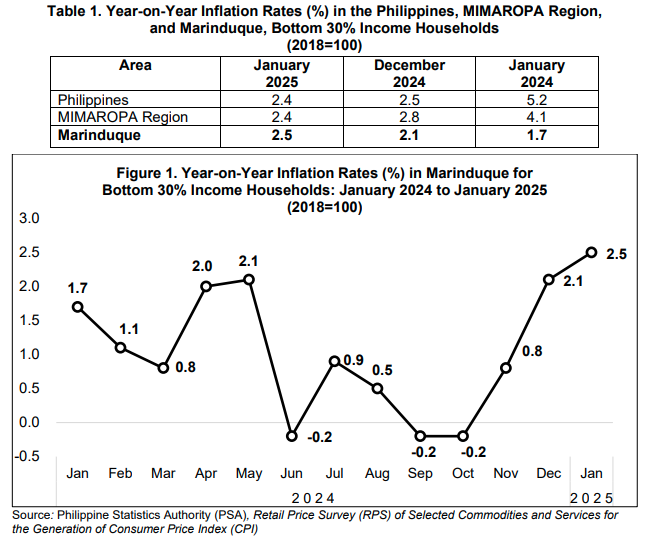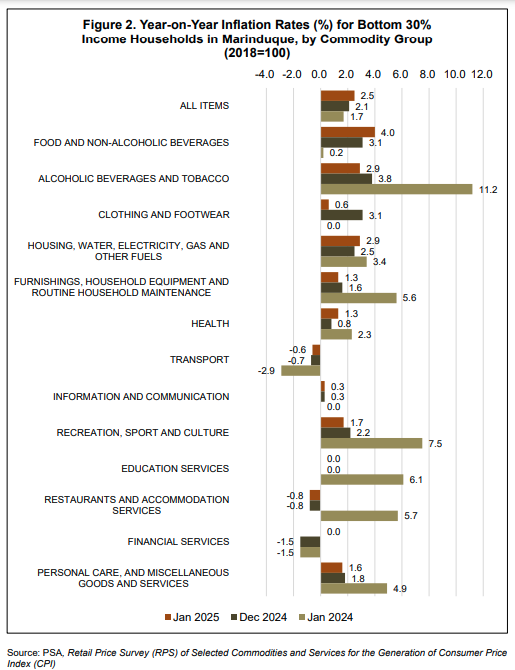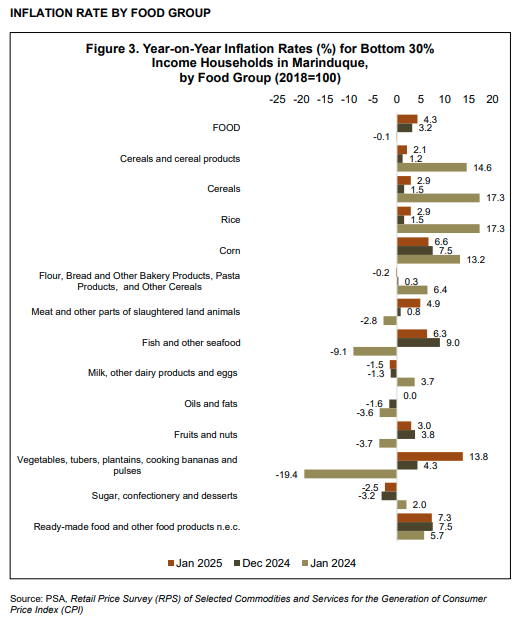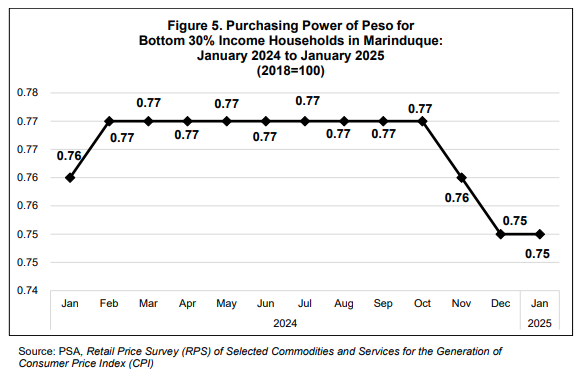INFLATION RATE FOR BOTTOM 30% INCOME HOUSEHOLDS

The headline inflation rate at the provincial level increased to 2.5 percent in January 2025, an increase of 0.4 percentage points from the inflation rate of 2.1 percent recorded in the previous month (December 2024). In the same reference month of the previous year (January 2024), the inflation rate was lower at 1.7 percent.
The uptrend of inflation in January 2025 was mainly driven by the combined acceleration in the indices for selected commodity groups such as food and non-alcoholic beverages at 4.0 percent, housing, water, electricity, gas and other fuels at 2.9 percent, and transport at -0.6 percent.

Furthermore, the annual index of the following commodity groups also showed higher growth compared to the figures from the previous month:
• Health, 1.3%; and
• Financial Services, 0.0%
On the other hand, lower annual increments were observed in the inflation rates of the following commodity groups:
Alcoholic Beverages and Tobacco, 2.9%;
• Clothing and Footwear, 0.6%;
• Furnishings, Household Equipment, and Routine Household Maintenance, 1.3%;
• Recreation, Sport, and Culture, 1.7%; and
• Personal Care, and Miscellaneous Goods and Services, 1.6%
Meanwhile, the indices of the following commodity groups maintained compared with the annual figures from the previous month:
• Information and Communication, 0.3%;
• Education Services, 0.0%; and
• Restaurants and Accommodation Services, -0.8%.

The province’s food index further accelerated to 4.3 percent in January 2025, from 3.2 percent in the previous month. This was equivalent to a change of 1.1 percentage points. In January 2024, the food inflation rate was lower at -0.1 percent. The uptrend in food inflation was mainly due to the acceleration in the indices of vegetables, tubers, plantains, cooking bananas and pulses at 13.8 percent, meat and other parts of slaughtered land animals at 4.9 percent, and, rice at 2.9 percent.
Furthermore, the annual indices of the following food items exhibited higher growth when compared with the annual figure from the previous month, as follows:
• Oils and fats, 0.0%; and,
• Sugar, confectionery and desserts, -2.5%.
On the other hand, the annual indices of the following food items exhibited lower growth when compared with the annual figure from the previous month, as follows:
• Corn, 6.6%;
• Flour, Bread and Other Bakery Products, Pasta Products, and Other Cereals, -0.2%;
• Fish and other seafood, 6.3%;
• Milk, other dairy products and eggs, -1.5%;
• Fruits and nuts, 3.0%; and,
• Ready-made food and other food products n.e.c., 7.3%.
PURCHASING POWER OF PESO
The Purchasing Power of Peso (PPP) for the Bottom 30% Income Households in Marinduque maintained at PhP 0.75 in January 2025. The PPP was registered at PhP 0.76 in January 2024. As a result, the amount of goods that can be presently purchased by consumers were fewer compared to when the PPP was higher

TECHNICAL NOTES
Consumer Price Index is an indicator of the change in the average prices of a fixed basket of goods and services commonly purchased by households relative to a base year.
Market Basket is a sample of goods and services, which is meant to represent the totality of all the goods and services purchased by households relative to a base year.
To determine the commodities that will form the market basket for the 2018-based CPI, the Survey of Key Informants (SKI) was conducted in March 2021. The survey, which was conducted nationwide to store managers, sellers or proprietors, obtained information on the most commonly purchased of goods and availed of services by the households.
The commodities in the 2018-based CPI market basket are grouped/classified according to the 2020 Philippine Classification of Individual Consumption According to Purpose (PCOICOP) which is based on the United Nations COICOP. Meanwhile, the commodities in the 2012-based CPI market basket used the 2009 PCOICOP version of classification of commodities.
Base year is a reference period, usually a year, at which the index number is set to 100. It is the reference point of the index number series. The CPI is rebased from base year 2012 to base year 2018.
Inflation Rate is the annual rate of change or the year-on-year change in the Consumer Price Index (CPI).
Purchasing Power of Peso is a measure of the real value of the peso in a given period relative to a chosen reference period. It is computed by getting the reciprocal of the CPI and multiplying the result by 100
Inflation Rate (reference month, reference year)
= [(CPI (reference month, reference year) - CPI (reference month, previous year)) / CPI (reference month, previous year)] x 100%
For example,
INFLATION RATE (January 2025) = [(CPI (January 2025) - CPI(January 2024)) / CPI(January 2024)] x 100%
= [(134.2 – 130.9) / 130.9] x 100%
= (3.3 / 130.9) x 100%
≈ 2.5%
(SGD)GEMMA N. OPIS
Chief Statistical Specialist
PSA PSO Marinduque

